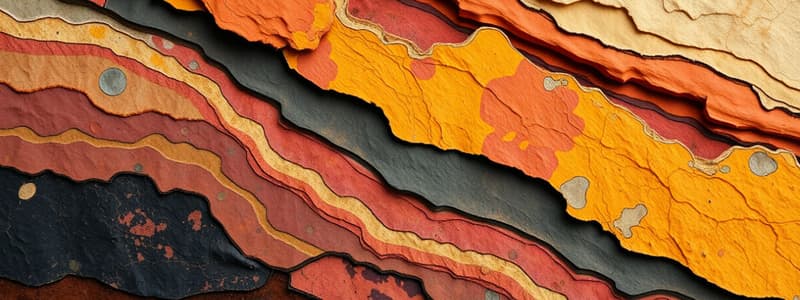Podcast
Questions and Answers
What is an unconformity?
What is an unconformity?
- A layer of rock that has been completely eroded away
- A surface where eroded rock layers have younger rocks deposited on top (correct)
- A solid boundary between two types of rocks
- A surface where older rock layers are exposed without any younger layers on top
Unconformities indicate a complete record of geological history.
Unconformities indicate a complete record of geological history.
False (B)
What are index fossils and why are they useful?
What are index fossils and why are they useful?
Index fossils are species that existed for a short time and were abundant, helping geologists determine the age of rock layers.
A __________ is created when sedimentary layers are deposited on top of eroded, older igneous or metamorphic rock layers.
A __________ is created when sedimentary layers are deposited on top of eroded, older igneous or metamorphic rock layers.
Match the types of unconformities with their descriptions:
Match the types of unconformities with their descriptions:
Which of the following best describes correlation in geology?
Which of the following best describes correlation in geology?
Fossils are effective for precise dating over extremely long time spans.
Fossils are effective for precise dating over extremely long time spans.
How do geologists fill gaps in the rock record?
How do geologists fill gaps in the rock record?
What are key beds used for in geology?
What are key beds used for in geology?
The principle of superposition indicates that layers above a key bed are older than those below it.
The principle of superposition indicates that layers above a key bed are older than those below it.
What is the current eon that Earth is in?
What is the current eon that Earth is in?
The current era is known as the ______ era.
The current era is known as the ______ era.
Which unit of the geologic time scale is the longest?
Which unit of the geologic time scale is the longest?
Fossil changes in rock layers are used to create boundaries in the geologic time scale.
Fossil changes in rock layers are used to create boundaries in the geologic time scale.
What is the purpose of the geologic time scale?
What is the purpose of the geologic time scale?
Match the units of the geologic time scale with their correct descriptions:
Match the units of the geologic time scale with their correct descriptions:
Flashcards are hidden until you start studying
Study Notes
Unconformities
- Unconformity is a surface resulting from erosion, creating a gap in the rock record.
- Forms when new sedimentary rock layers are deposited on top of eroded, older rock layers.
- Represents a significant gap in geological time rather than a simple hole.
Types of Unconformities
- Disconformity: Younger sedimentary layers lie atop older, eroded horizontal sedimentary layers.
- Angular unconformity: New layers are deposited over tilted or folded, previously eroded sedimentary layers.
- Nonconformity: Younger sedimentary layers are placed on top of eroded older igneous or metamorphic rock layers.
Filling Gaps in the Rock Record
- Incomplete rock records often necessitate using other rock features and fossil evidence for correlation.
- Correlation: Process of matching rock layers and fossils from different locations to create a cohesive geological timeline.
- Geologists identify similarities in rock formations as they traverse landscapes, even when soil or erosion obscures layers.
Fossils and Age Inference
- Fossils serve as crucial indicators of geological history but lose effectiveness over extended time spans.
- Index fossils: Represent species with a short existence, high abundance, and wide distribution; crucial for dating rock layers.
- Notable examples include trilobites, which assist in inferring the age of rock layers across regions.
Major Geologic Events and Earth's Timeline
- Major geologic events can leave distinctive layers, known as key beds, that geologists use for correlation.
- Key beds: Unique layers that facilitate the connection of rock layers across various regions.
- Principle of superposition states that layers above a key bed must be younger than those below.
Determining Relative Order of Events
- Geologists rely on the type and order of rocks, fossils within them, and evidence of major events to establish a relative timeline.
- They combine principles of relative-age dating alongside fossil records to understand the sequence of geological events.
The Geologic Time Scale
- Geologic time scale: A model outlining Earth's history from its formation 4.6 billion years ago to present.
- Time is organized into eons (largest units), with current eon being the Phanerozoic.
- Eons are further divided into eras, with the current era being the Cenozoic, followed by periods and epochs.
- The Quaternary period is Earth’s current period, which includes the Holocene epoch.
- Geologists establish time unit boundaries based on observable changes in rock layers and fossil records, leading to unequal time divisions on the scale.
Studying That Suits You
Use AI to generate personalized quizzes and flashcards to suit your learning preferences.



